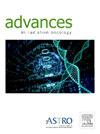HyperSHArc:质子、氦和碳离子弧治疗多发性脑转移瘤的单等中心立体定向放射手术
IF 2.7
Q3 ONCOLOGY
引用次数: 0
摘要
目的本文介绍了一项关于 HyperSHArc、点扫描强子弧(SHArc)疗法的概念验证研究,该疗法用于多发性脑转移瘤(MBMs)的单等中心立体定向放射外科治疗。使用质子、氦离子和碳离子的 HyperSHArc 计划与最先进的容积调制光子弧疗法进行了比较。规划和给药方法考虑了专用能量、点和多弧选择策略。质子、氦和碳HyperSHArc计划是为颅内有3到11个病灶、肿瘤总体积(GTV)在0.03到19.8毫升之间的MBM患者制定的,单次剂量在19到21Gy之间。规划靶体积(PTV)考虑了GTV周围1毫米的各向同性边缘,并根据2.5%/1毫米的范围和位置不确定性标准进行了稳健优化。使用HyperArc®单等中心立体定向放射手术平台(美国加利福尼亚州帕洛阿尔托市瓦里安公司)优化了光子超弧容积调制弧治疗(HA-VMAT)计划的PTV。与HA-VMAT相比,粒子弧计划在健康大脑中减少了V2Gy和V4Gy,而中间剂量(V8Gy-V16Gy)与HA-VMAT相似或减少,取决于病变的数量。特别是在有 11 个靶点的情况下,观察到 V12Gy 大幅减少,这可能与降低治疗诱发放射性坏死的风险有关。使用碳离子的 HyperSHArc 增强了靶体内的剂量平均线性能量转移,从而克服了放射抗性因素(100 keV/μm)。结果表明,使用 HyperSHArc 可以实现与 HA-VMAT 相当或更高的剂量一致性,同时减少低剂量浴,增加 GTV 中的平均剂量平均线性能量转移。我们的研究结果表明,使用轻离子和重离子的 HyperSHArc 可以成为治疗 MBM 的有效手段。进一步发展 HyperSHArc 的优化和传输是合理的。本文章由计算机程序翻译,如有差异,请以英文原文为准。
HyperSHArc: Single-Isocenter Stereotactic Radiosurgery of Multiple Brain Metastases Using Proton, Helium, and Carbon Ion Arc Therapy
Purpose
This work presents a proof-of-concept study of HyperSHArc, spot-scanning hadron arc (SHArc) therapy for single-isocenter stereotactic radiosurgery of multiple brain metastases (MBMs). HyperSHArc plans using proton, helium, and carbon ions were compared with state-of-the-art volumetric modulated photon arc therapy.
Methods and Materials
Treatment design and optimization procedures were devised using commercial and in-house treatment planning systems. Planning and delivery methods considered dedicated energy, spot, and multiarc selection strategies. Proton, helium, and carbon HyperSHArc plans were generated for patients with MBM exhibiting 3 to 11 intracranial lesions with gross tumor volumes (GTVs) between 0.03 and 19.8 cc, at prescribed doses between 19 and 21Gy in a single-fraction. Planning target volumes (PTVs) considered a 1-mm isotropic margin around the GTV, and robust optimization with 2.5%/1 mm criteria for range and position uncertainty was applied. Photon hyper-arc volumetric modulated arc therapy (HA-VMAT) plans were optimized for the PTVs using the HyperArc® single-isocenter stereotactic radiosurgery platform (Varian, Palo Alto, CA, USA).
Results
HyperSHArc plans were comparable between particle species, achieving highly conformal target doses and satisfying clinical coverage criteria. Particle arc plans reduced V2Gy and V4Gy in the healthy brain compared with HA-VMAT, while intermediate doses (V8Gy-V16Gy) were similar or reduced depending on the number of lesions. Particularly for the case with 11 targets, a considerable reduction in V12Gy was observed that could be relevant for reducing the risk of treatment-induced radionecrosis. HyperSHArc using carbon ions boosted dose-averaged linear energy transfer inside the target relevant to overcoming radioresistance factors (>100 keV/μm).
Conclusions
We present the first particle arc therapy strategies for MBM. Results demonstrate that with HyperSHArc, dose conformity comparable or superior to HA-VMAT is achievable while reducing the low-dose bath and increasing mean dose-averaged linear energy transfer in the GTV. Our findings suggest that HyperSHArc using light and heavy ions could be an effective and efficient means of treating MBM. Further development of HyperSHArc optimization and delivery is justified.
求助全文
通过发布文献求助,成功后即可免费获取论文全文。
去求助
来源期刊

Advances in Radiation Oncology
Medicine-Radiology, Nuclear Medicine and Imaging
CiteScore
4.60
自引率
4.30%
发文量
208
审稿时长
98 days
期刊介绍:
The purpose of Advances is to provide information for clinicians who use radiation therapy by publishing: Clinical trial reports and reanalyses. Basic science original reports. Manuscripts examining health services research, comparative and cost effectiveness research, and systematic reviews. Case reports documenting unusual problems and solutions. High quality multi and single institutional series, as well as other novel retrospective hypothesis generating series. Timely critical reviews on important topics in radiation oncology, such as side effects. Articles reporting the natural history of disease and patterns of failure, particularly as they relate to treatment volume delineation. Articles on safety and quality in radiation therapy. Essays on clinical experience. Articles on practice transformation in radiation oncology, in particular: Aspects of health policy that may impact the future practice of radiation oncology. How information technology, such as data analytics and systems innovations, will change radiation oncology practice. Articles on imaging as they relate to radiation therapy treatment.
 求助内容:
求助内容: 应助结果提醒方式:
应助结果提醒方式:


